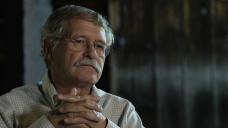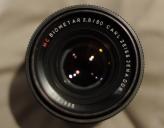
-
Contax 85mm f1.4 stellar glass, and flares better than the Cosina Zeiss ZF/ZE versions. If the f1.4 is too expensive, the f2.8 Sonnar is equally brilliant. This one reproduces fantastic colors, as all Sonnars do.
-
@RRRR here's a screen grab (-2-2,0-2) from a sit down interview did recently. I'll look for a few more for ya. Bokeh is definitely creamy. Artifacting is of course from jpeg compression.

 Zeiss85mm.jpg1920 x 1080 - 103K
Zeiss85mm.jpg1920 x 1080 - 103K -
-
@RRRR I think we were at 2.8.
-
I'm 5mm off topic here! Ive been offered this lill' '80mm f2.8 Biometar Zeiss' baby for 100 notes and it seems pretty damn sharp edge to edge especially at f8. Anyone used medium format lenses like this? pm me and tell me if its worth the hassle.
As for 85mm oldie lenses I still love my Canon 85mm f/1.2 L Aspherical and despite it being 'not fit for junk formats such as m43' as some purists believe, I shot a lot of my closeups up on it during my latest film with it and was perfectly happy with the results - and I love that softness 'in tight' it brings.

 biometer80mmlens.jpg2929 x 2291 - 870K
biometer80mmlens.jpg2929 x 2291 - 870K -
That Canon is a great lens, but still an electronic lens.
Nothing wrong with medium format lenses, but they are normally slower and heavier than their 35mm counterparts. You're gonna love the mechanics, though!
-
Really best lens 85mm I seen is Canon FD 85mm 1.2 L. It is not for Canon EF for sure, but I've very impressed after Samyang 85mm 1.4 on GH2.
Canon FD 85mm 1.2 has best bokeh I've seen at GH2. It brings very cinematic look, sharp from 1.2 (50 1.2 FD not L not sharp at all @1.2-1.4), minimum flares, best colors. I bought it after Olympus 75 1.8 and I very shame that I almost stopped using Olympus 75mm for video with both GH2 and OMD. It is rare lens and I just sorry that I haven't tried 85mm 1.2 FD L before 75mm 1.8.
-
I'll second the 85mm 1.2L. It's as creamy as it gets in that size and looks incredible totally wide open, unlike most lenses. It's very expensive though.
-
I slightly disappointed by Zeiss 80mm f/2.8 "zebra" for Pentacon six at MINT contition. I bought it after great review by Frank Glankairn about middle-format optics with DSLR video. Overall it very good lens but not at 2.8. Canon EF 85mm 1.8 bit Zeiss at my comparison test. So Zeiss 80mm 2.8 bores at locker more that 2 years.
-
The Zeiss Jena (east) Pentacon lenses have a lot of sample variation. You can find gems and lemons alike.
-
Pentax Takumar 85mm 1.8
-
From my Canon FD lenses, the 85mm f1.8 is my preferred one.
-
I know the focus here is on 85mm focal length, but thought I would mention the SP 90mm f/2.5 adaptall-2 from Tamron (52B or 52BB). Not quite as fast as the 85mm lenses previously discussed, but can be found at very reasonable prices and is interestingly suited for videography- it's contrasty but not too contrasty and has a fantastic focus ring. Bokeh is quite buttery.
I haven't shot any video with it yet but have loved it for stills work on my Pentax gear.
-
Here are a couple still samples of the above mentioned tamron 90mm adaptall-2 lens. First is at f/4.0, the second wide open (f/2.5). Shot on a Pentax K-7.

 tamron-90mm-sample-1.jpg1800 x 1196 - 1018K
tamron-90mm-sample-1.jpg1800 x 1196 - 1018K
 tamron-90mm-sample-2.jpg1196 x 1800 - 870K
tamron-90mm-sample-2.jpg1196 x 1800 - 870K -
I agree that everyone needs an 85mm lens. My favorite is the Olly 45mm, which is a 90mm on the gh2. I don't think anyone really needs a 160mm as a first priority lens, so it makes sense to buy a good legacy lens in the focal length. My old Nikkor 85/2 is very nice, but I only use it for balcony shots on the GH2 because it is pretty long.
-
The thing is that crop factor (well, field of view) is not directly linked in any way to the optical characteristics of the focal length of the given lens - depth of field, telephoto compression in particular. These factors stay the same, no matter what the sensor form factor is.
I am look forward to doing more dramatic productions and am considering the 90mm tamron as an important tool to get intense closeups of talent, tight b-roll, etc. I want that hyper-thin DOF plane for some shots.
On a shoot for a trailer for my friends' production of a play, we used a 50mm and an 80-210mm zoom at around 85mm for two different framings of the shots. The workaround factor of the m 4/3rd's crop factor (moving back) didn't come into play as I wanted extremely tight 2/3 middle of the face shots- I just re-shot each segment with the talent at the same marks, first with the 50mm and then the zoom at 85mm. Worked perfectly, got the impact of the tight shots without having to move the camera at all.
Link to trailer here:
(just click, it'll play on Vimeo). -
The crop factor is linked to one important property of the lens, which is the inverse square of the light from the source. Because of the crop factor, you will be twice as far away, which means that the light will on average have 4 times less color information. Of course, sometimes you really want to shoot at a distance, but there is a reason why video from a distance looks mushy, the light is simply way more diffuse.
Of course if you can afford a metabones gizmo, it becomes a different story.
-
@virgilr I was just educated in this area and I always wondered why the compression of my 85mm lenses didn't look any different than full frame. Just how wide the scene looked. I always believed it changed the focal length but now I can see the light and it makes perfect sense ;)
-
@drDave you're right but it depends on the shot, doesn't it? That was my point- the properties of the lens remain and if you're in a controlled lighting situation and the lens gives you the creative result you want you can manage the lighting. From what little I have gleaned an 85mm was used in Upstream Color which has won multiple awards and was shot on a GH2.
-
@virgilr Absolutely it is an artistic choice, I just think an 85 on a GH2 is not the same as an 85 on a Canon 5D MKII. I just don't see that, and in my own work the quality of the light makes more of a difference than the lens. I actually don't care if someone won an award, either, I mean, if you want that look, just go for it. I think most films that win awards looks processed, like Velveeta. The LOR won every award and some of it was as bad as Trek-con on the last day. For me, an 85 on a GH2 is a great balcony lens, and on the 5D is a great portrait lens. I see the other point of view, but I don't see that they are the same. OTOH, the 45 Olly on the GH2 is a totally awesome portrait lens. Waiting for my own set of speedboosters.
-
The problem here is trying to use stills conventions in a motion picture setting. It's safe to assume someone is doing that when they bring up any film (in this case, Upstream Color). In motion pictures the 85mm is a close-up lens that will be pulled out only when you are shooting a close-up and want pronounced bokeh...and are likely working in a large enough room to allow. Though not totally absent, you're likely to see focal length's on either side of this in cine reference...65mm, 75mm and then jump to 100mm, 110mm.
It's safe to say that Upstream Color did not have this lens on an GH2 for a considerable portion of the film. It would have been pulled out for extreme close-ups or when they had the room (and stability) to do a wider shot where depth compression was desired. It's not a general purpose lens in the context of filmmaking or the GH2 specifically. It's a lens you pull out for a specific purpose.
A majority of a given film is going to be at 40mm or under. There are fewer 5D films out there than there are VistaVision films. 36mm/135/"FF" shouldn't ever be used as a metric unless you know the film is one of only a handful using that acquisition size.
-
@BurnetRhoades- thank you for the insight from the traditional cinematography perspective! I haven't seen all of Upstream Color- just some trailer/outtake clips and I totally agree that use of an 85mm lens is indeed minimal. I think the exciting thing is that the expression and creativity in film making is being somewhat redefined with the advent of quality motion picture acquisition with what are essentially still cameras. The classic film making methods obviously apply from classic cinematography, but the use of the DSLR for film making allows for new ideas in the art. It's a new path where a hybrid hat can be worn to solve problems, tools that can be borrowed from both disciplines and (hopefully) new meaningful and beautiful films will be made! That's why I decided to use the example of Upstream Color- Shane Carruth doesn't come from any background other than wanting to tell his story his way. He's using the tools at hand to make that happen. I'm itching to learn more from the traditional cinematography world to better realize some upcoming projects, and it's awesome to get the kind of information in threads like this!
-
Test of EF mount 85mm lenses - Canon EF 85mm ƒ/1.8 USM и EF 85mm ƒ/1.2L USM, Sigma AF 85mm ƒ/1.4 EX DG HSM (in Russian, use google translate or just check images)
-

 sample554.jpg800 x 532 - 98K
sample554.jpg800 x 532 - 98K
Howdy, Stranger!
It looks like you're new here. If you want to get involved, click one of these buttons!
Categories
- Topics List23,993
- Blog5,725
- General and News1,354
- Hacks and Patches1,153
- ↳ Top Settings33
- ↳ Beginners256
- ↳ Archives402
- ↳ Hacks News and Development56
- Cameras2,368
- ↳ Panasonic995
- ↳ Canon118
- ↳ Sony156
- ↳ Nikon96
- ↳ Pentax and Samsung70
- ↳ Olympus and Fujifilm102
- ↳ Compacts and Camcorders300
- ↳ Smartphones for video97
- ↳ Pro Video Cameras191
- ↳ BlackMagic and other raw cameras116
- Skill1,960
- ↳ Business and distribution66
- ↳ Preparation, scripts and legal38
- ↳ Art149
- ↳ Import, Convert, Exporting291
- ↳ Editors191
- ↳ Effects and stunts115
- ↳ Color grading197
- ↳ Sound and Music280
- ↳ Lighting96
- ↳ Software and storage tips266
- Gear5,420
- ↳ Filters, Adapters, Matte boxes344
- ↳ Lenses1,582
- ↳ Follow focus and gears93
- ↳ Sound499
- ↳ Lighting gear314
- ↳ Camera movement230
- ↳ Gimbals and copters302
- ↳ Rigs and related stuff273
- ↳ Power solutions83
- ↳ Monitors and viewfinders340
- ↳ Tripods and fluid heads139
- ↳ Storage286
- ↳ Computers and studio gear560
- ↳ VR and 3D248
- Showcase1,859
- Marketplace2,834
- Offtopic1,320











